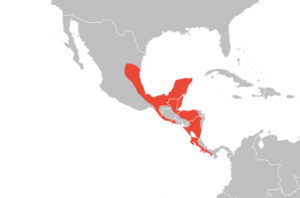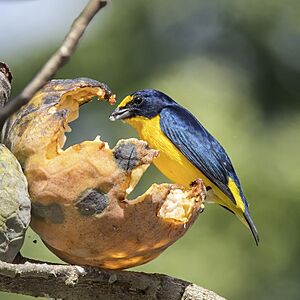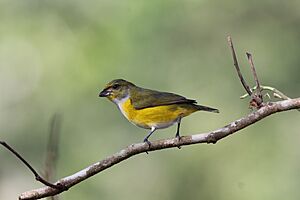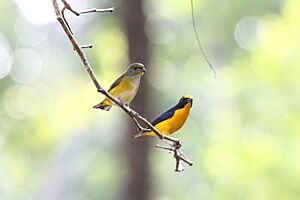Yellow-throated euphonia facts for kids
Quick facts for kids Yellow-throated euphonia |
|
|---|---|
 |
|
| Male E. h. hirundinacea, Honduras | |
| Conservation status | |
| Scientific classification | |
| Genus: |
Euphonia
|
| Species: |
hirundinacea
|
 |
|
| Distribution of the yellow-throated euphonia (red) | |
| Synonyms | |
|
|
The yellow-throated euphonia (Euphonia hirundinacea) is a small songbird. It belongs to the finch family. You can find it in southeastern Mexico and all across Central America. Its home stretches from Belize down to western Panama.
This bird likes places that are both wet and dry. It prefers the edges of forests, open woodlands, and shady farms. There are two types, or subspecies, of this bird. They are Euphonia hirundinacea hirundinacea and Euphonia hirundinacea gnatho.
The yellow-throated euphonia is a small bird. It has pointed wings, a short beak, and a short tail. Male birds have shiny dark blue-black feathers on their upper parts. They also have a yellow spot on their forehead and bright yellow underparts. Female birds are olive green on top. Their chest and lower parts are whitish-gray. This bird has a high-pitched song. It can even copy calls from other birds!
This bird mainly eats fruits, especially mistletoe berries. It swallows these berries whole. They have also been seen eating figs and ripe bananas. Yellow-throated euphonias build their nests and raise their young between March and August. Both parents help build the nest and feed the baby birds. This species is not considered endangered. Its population is stable and it lives in a large area.
Contents
About the Yellow-throated Euphonia
The yellow-throated euphonia is one of 27 species in the Euphonia group. These birds live in trees in the Neotropics. Euphonias are special because they don't have a strong stomach (called a gizzard). This is because they eat a lot of fruit. Their nests are shaped like a dome with an opening on the side.
Male and female euphonias look different. This is called sexual dimorphism. Males have shiny dark blue feathers on their backs and yellow on their bellies. Females are usually olive-colored on top. Their undersides can be yellow or gray.
Scientists used to think euphonias were part of the tanager family. But new studies show they are actually part of the finch family. They are closely related to the Carduelinae finches. This means finches traveled a lot between continents long ago. Euphonias then found a special way of life in the Neotropics.
There are two main types of yellow-throated euphonias:
- Euphonia hirundinacea hirundinacea (the most common type)
- Euphonia hirundinacea gnatho
The E. h. gnatho type has a bigger beak. Its upper feathers are more bottle-green than bluish. Female E. h. gnatho birds also have yellower underparts.
What Does It Look Like?
The yellow-throated euphonia is a small bird. It has a short beak and tail. Its wings are pointed. An adult bird is about 10–12 centimeters (4–5 inches) long. Its tail is about 3.3 to 3.6 cm (1.3–1.4 inches) of that length. Its wingspan is about 5.8 to 6.1 cm (2.3–2.4 inches). It weighs about 11.6 to 17.8 grams (0.4–0.6 ounces).
Male Birds
Adult male birds of the common type have a small, bright yellow patch on their forehead. This patch goes back to about the middle of their eyes. The rest of their head and upper body are shiny blue-black. This includes their upper-wing feathers and tail feathers. Their flight feathers are black with steel blue edges. Their entire underside is yellow. The feathers under their wings are white. The feathers under their tail are dark gray.
The inner parts of the outer 2-3 tail feathers are mostly white. This creates a large, white, oval shape under their wings. Their beak tip is black. It turns blue-gray under their nostrils and on their lower beak. Their eyes are brown. Their legs and feet are dark gray.
Female Birds
Adult female birds have an olive-green color on top of their head and upper body. This color has a slight metallic shine. Their throat, the middle of their chest, and lower parts are whitish to grayish-white. The sides of their chest and body are bright yellowish-olive green. The feathers under their tail are pale olive-yellow. Their beak looks similar to the male's.
Young Birds
Young male birds look like females. But their feathers are softer. The olive-green on their upper parts is not shiny. Young males also look like females at first. They start to get yellow feathers on their throat and middle underparts. Then their whole belly turns yellow. After that, black feathers start to appear. Males then get a black mask. Their crown and head turn black, or a mix of black and olive. Their back, sides, and wings start olive-green. These are the last parts of the bird to turn dark blue.
Bird Calls and Songs
The male's song has high-pitched, squeaky notes. These notes often change quickly in a choppy pattern of 2-4 notes. Some males can copy notes from other birds. But they don't copy as many as some related euphonia species.
Their calls include a fast "pidgel-eece" or a chattery "chi-bib-bib-bib-bib." They also make a rough, hurried "tuck-a-tuck" or "chuck-a-chuck." Other calls are a clear "weet" and a full "queer" or "gleer." Their calls are often short and sudden. Females make thin, high-pitched calls that sound almost like a trill.
How to Tell Them Apart
Male yellow-throated euphonias are easy to spot because of their yellow throat. But they can be confused with the thick-billed euphonia in parts of Costa Rica and Panama. Thick-billed euphonias also have a yellow throat. However, they have more yellow on their head. They are also more common where their ranges overlap.
Female yellow-throated euphonias are different from other euphonia females. They have a whitish or pale gray throat, chest, and belly. Their sides are yellow. Female scrub euphonias, thick-billed euphonias, and yellow-crowned euphonias have entirely greenish-yellow to yellow undersides. Female white-vented euphonias have whitish throats but a yellow chest.
Where Do They Live?
The yellow-throated euphonia lives in eastern Mexico. Its range goes from southern Tamaulipas down to Veracruz. It also lives south into Belize, Honduras, El Salvador, eastern Nicaragua, Costa Rica, and western Panama. The E. h. gnatho type is found in northeastern Nicaragua, Costa Rica, and western Panama.
These birds mostly live in dry to humid areas. They like forest edges, new growth forests, shady farms, and medium-height woods near rivers. You can find them from lowlands up to 2100 meters (about 6,900 feet) high in Mexico. In El Salvador and Costa Rica, they are mainly found in hills and plateaus. In western Panama, they are thought to live in foothills between 900 m and 1200 m (about 3,000-3,900 feet) high.
They usually stay in the same area all year. But they might move a little bit to find food. In Mexico, they might only visit the Pacific side of the Isthmus of Tehuantepec from October to May. In El Salvador, they are only seen in spring and summer. This might mean they migrate there.
Diet and Behavior
The yellow-throated euphonia eats almost only fruits and berries. They especially love mistletoe berries. They also eat a lot of figs and ripe bananas in some areas. People sometimes call them "mistletoe birds." They eat much fewer insects than fruits. When they do hunt for insects, they look through leaves and small branches. They also search on palm seed heads. They have been seen catching insects and feeding them to their young.
Mistletoe berries have a somewhat tough skin and a seed inside. Euphonias break the skin with their beaks. Then they swallow the single seed, which is covered in a sticky pulp. The seeds pass through their body whole. The bird gets all the nutrients without needing to grind the food. Because they eat such soft food, their stomach (gizzard) has changed. It's now a simple sac that lets food pass through quickly.
Reproduction and Life Cycle
Yellow-throated euphonias breed at different times depending on the place. They breed in May and August in Mexico. In Belize, it's June. In Guatemala, it's March–May. In Costa Rica, it's April–June.
Their nests are dome-shaped with an opening on the side. They build them from grass, leaves, roots, moss, and lichens. Nests can be placed anywhere from eye level to 15 meters (about 50 feet) high. They build them in stream banks, roadside banks, on tree trunks, branches, palm leaves, or in clumps of moss.
Yellow-throated euphonias usually lay five eggs. They lay one egg each day. The eggs hatch after about 15 days. The female bird sits on the eggs and young for about 6 or 7 days after hatching. Laying five eggs is a lot for a bird in the Neotropics. Other euphonia species usually lay three to four eggs. Their eggs are white with light brownish spots at the wider end.
Both parents build the nest together. After that, they always visit the nest in pairs. They almost always go to the nest entrance together. This might be a way for them to protect their mate or distract predators. Baby birds are fed mostly regurgitated fruits and seeds from the day they hatch. They leave the nest after 19 days. It's unusual that they feed their young mostly fruits and seeds. They don't seem to feed them many insects or other animal protein. This might be because their digestive system makes it hard to eat tougher foods.
Yellow-throated euphonias stay in pairs all year. But they don't defend their territory.
Yellow-throated Euphonias and People
The yellow-throated euphonia is currently listed as a species of "least concern." This means it's not endangered. Its population is stable. There's no sign that the number of adult birds is going down. Also, it lives in a very large area, about 1,440,000 square kilometers (about 556,000 square miles).
In 1892, some yellow-throated euphonias were kept in cages in San Jose, Costa Rica. But there isn't much information about how they interact with humans today. They seem to be okay with changes to their habitat. They often live in farms, new growth forests, and forest edges. They have even been seen nesting near human homes. They build nests in dirt road banks, about 1–3.5 meters (3–11 feet) above the ground. They also nest in rotting fence posts.





